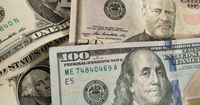The Mexican peso began the week on a strong note, appreciating against the U.S. dollar as of Monday, April 14, 2025. The dollar's price fluctuated throughout the morning, reflecting varying exchange rates across different banks in Mexico. As of 8:09 AM Central Time, the dollar was trading at approximately 20.08 pesos, marking a 1.1% increase from the previous Friday's closing rate.
According to Excélsior, the dollar's value in various banks was as follows: BBVA Mexico offered a buy rate of 19.23 pesos and a sell rate of 20.37 pesos; Citibanamex had rates of 19.69 pesos for buying and 20.82 pesos for selling; while Banco Azteca reported a buy price of 19.10 pesos and a sell price of 20.55 pesos.
In southeastern Mexico, the dollar maintained similar rates, with Banco Azteca continuing to provide competitive pricing. The exchange rates for the U.S. dollar were consistent across the region, with the buy rate at 19.74 pesos and the sell rate at 20.60 pesos.
This fluctuation in the dollar's price is attributed to various international factors, particularly the political landscape in the United States. Donald Trump, who recently won the 2024 presidential election against Kamala Harris, is expected to implement controversial economic policies that could impact the global economy significantly.
As reported by TV Azteca Yucatán, the dollar's price has shown notable differences compared to earlier in the day, emphasizing the necessity for citizens to stay informed about economic changes. The article highlights the importance of understanding these shifts, especially for those regularly involved in currency exchanges.
Market analysts from CIBanco noted that the Mexican peso could fluctuate between 19.95 and 20.60 pesos for the remainder of the week, largely influenced by Trump's tariff policies and any potential bilateral agreements that may emerge. The firm stated, "The Mexican foreign exchange market, like global markets, will remain heavily dependent on Trump's tariff issues, particularly if bilateral agreements are announced that allow for the reduction of tariffs."
Additionally, the Mexican Stock Exchange (BMV) experienced a positive start to the week, with the S&P/BMV IPC index rising by 1.73% to reach 52,391.35 points. This increase was buoyed by a favorable environment for risk assets following news that the White House exempted smartphones and computers from new tariffs on imports from China.
The dollar's price at Banco Azteca closed at 19.00 pesos for buying and 20.40 pesos for selling by the end of the trading day. Meanwhile, in Tijuana, the dollar's selling price reached 20.25 pesos.
In the cryptocurrency market, Bitcoin also saw a rise, closing at $84,750 per unit, reflecting a 1.26% increase. In Mexican pesos, Bitcoin's opening price was approximately 1,701,823 pesos per unit.
Oil prices also experienced an uptick, with Brent crude oil priced at $64.88 per barrel and West Texas Intermediate (WTI) at $61.53 per barrel. These increases were largely due to the exemptions from tariffs on certain electronic products and a strong rebound in crude imports from China, although concerns about a potential global economic slowdown lingered.
As the week progresses, it remains crucial for individuals and businesses to monitor these economic indicators closely. The interplay between local currency values and international political decisions highlights the interconnected nature of the global economy.
In summary, the Mexican peso's strength against the dollar reflects broader trends in the economy and the potential implications of U.S. political actions. The fluctuations in exchange rates are a reminder of the volatility in financial markets and the importance of staying informed.




